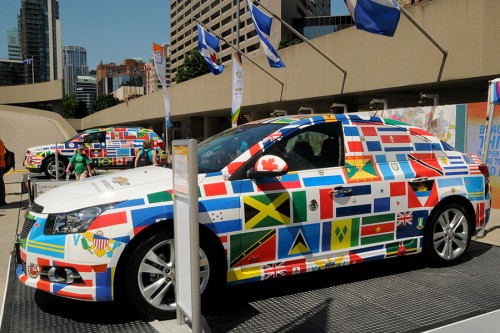Wrapped in flags
Fittingly for an automaker, Chevrolet’s display area at the festival also showcased vehicle graphics, with a sedan and a sport utility vehicle (SUV) wrapped in the flags of the nations that will compete in the games, along with the Toronto Pan Am 2015 logo.
“We’ve had that wrap in place for a while now, as our sponsorship of the games began a few years ago,” says Mowat. “It’s been to auto shows and other ‘milestone’ Pan Am events.”
Chevrolet will roll out more such wraps in the months to come, as it unveils a fleet of more than 1,000 vehicles for the games.
“Some of the vehicles will be fully wrapped,” says Mowat. “All of them will at least feature logos and decals.”

Following the completion of the puzzle, the mural will be showcased at different venues relating to the Pan Am Games. Photos courtesy Chevrolet Canada
A clock like no other
Meanwhile, the countdown clock and kiosk were ‘woken from slumber’ at the festival by a team of acrobats on stilts from Montreal-based Cirque du Soleil (another premier partner of the games), Brazilian drummers and breakdancers performing a charivari discordant serenade and BMX cyclists doing tricks around the two structures.
The 5.5-m (18-ft) tall, 4.1-m (13.5-ft) wide and 1.2-m (4-ft) thick countdown clock is decorated with the games’ colourful sports pictograms and showcases five 1.2-m (47-in.) DynaScan industrial-grade liquid crystal displays (LCDs)—four on the front, one on the back—counting down the days, minutes and seconds to the start of the games and playing a series of videos every five minutes. Each of the screens boasts 2,500 candelas per square metre (cd/m2) of luminance to ensure content is legible in daylight.
Weighing 7.3 t (8 tons) and connected to 5 km (3.1 mi) of dedicated fibre optic cabling infrastructure running underground to a downtown Cisco data centre—reportedly capable of sending one gigabit of data per second, equivalent to the Internet connectivity requirements of a community of 25,000 homes—the clock will remain on-site until the Parapan Games end on August 15, 2015.
“It’s the first of its kind in the world and it will be an important landmark for locals and visitors alike, announcing the games are quickly approaching,” says Nitin Kawale, president of Cisco Canada, which developed the clock as a premier partner and official information and communications technology (ICT) provider for the games. “This is more than just a clock; it’s a social portal enabled by the ‘Internet of Everything.’”
“For athletes, the clock is a reminder of how close the games are,” says Ryan Homsy, a handball goalie who has competed at the Pan Am Games twice before and serves as an ‘ambassador’ for Cisco. “As a member of the Canadian handball team, I’m proud to have been there to unveil the clock and look forward to helping win a medal on home soil.”
The clock was fully funded and constructed by Cisco and its partners. Housed in a metal frame with an aluminum exterior cladding, it and the kiosk took a combined 7,000 hours from 40 people to build, including 28 Cisco engineers.

The mural was flanked by some of Chevrolet’s graphic-wrapped vehicles, featuring the flags of nations that will compete in the games.
“The planning began about six months ago,” says Jeff Seifert, Cisco’s chief technology officer (CTO). “We also had students from George Brown College in Toronto and University of Ontario Institute of Technology (UOIT) in Oshawa, Ont., help assemble the clock.”
The clock contains six Cisco 3010 industrial Ethernet switches—including five video and one audio—to connect to the LCD panels. Further, Cisco’s iServices software platform operates the clock, supported by the company’s unified computing system (UCS) and protected by ASA-55/85X firewalls and Sourcefire intrusion software.
Besides those components, however, the large structure called for specialized skills beyond Cisco’s in-house capabilities. Toronto-based Fourth Wall Media, a digital out-of-home (DOOH) and kiosk agency that serves as Pattison Outdoor Advertising’s ‘experiential’ marketing division, oversaw the development of the physical structure, based on mockups created in-house using a three-dimensional (3-D) printer, and facilitated the flow of content from Toronto 2015 (TO2015) Organizing Committee.
“We’ve been involved in big projects before, like an 8.5-m (28-ft) tall replica lighthouse in downtown Toronto last year for Nova Scotia Tourism,” says Dmitri Melamed, vice-president (VP) of production. “In this case, we brought all of the necessary partners together on the same page, procured some of the equipment and facilitated bench-testing for fabrication, which began about one month before the clock’s debut at the countdown festival.”
These partners included Enseicom, a sign, billboard and street furniture manufacturer based in Lachine, Que., which fabricated weatherproof cabinets to protect Cisco’s technology inside the clock and kiosk; Optimum Graphiques, a large-format print house in Laval, Que., which produced the vinyl pictograms for the exterior surface; and X2O Media, a Montreal-based digital signage software developer.
“We are a longtime partner of Cisco and have worked with their digital signage media players before, so it was quite natural that they reached out to us,” says Vern Freedlander, X2O’s VP of production. “Our contribution for this project was more of a process than a product. We built the user experience, so our challenge was to design a compelling interface that would allow visitors to navigate intuitively through content, including wayfinding, news, information and video clips. Our graphic designers also had to maintain the TO2015 branding.”
The clock and kiosk were delivered to Toronto on a 16-m (53-ft) flatbed transport truck and placed into position with a 15-t (16.5-ton) Broderson deck crane. Fourth Wall co-ordinated the project with on-site engineering firm Blackwell and commercial sign installation, maintenance and repair contracting firm Trade Sync, based in Brantford, Ont.
“They’ve installed at lot of the digital signage at Toronto’s Yonge-Dundas Square,” says Melamed.
Since the clock is about the same height as the average male giraffe, it is hard to miss. During the games, it will broadcast sports footage to crowds in the square. It also helps draw attention to the more human-scale kiosk that serves as a window to the aforementioned social portal.







